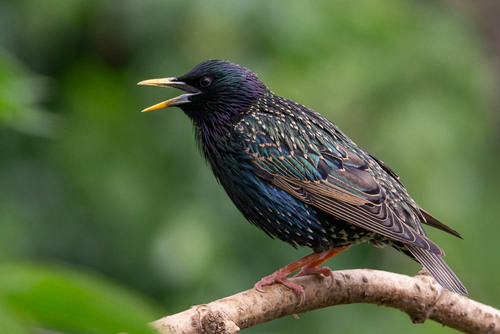
European Starling
The European Starling (Sturnus vulgaris) is a highly adaptable and widespread bird species, originally native to Eurasia but now found on every continent except Antarctica. Known for their impressive murmurations, where thousands of birds fly in synchronized patterns, starlings play a complex ecological role. While they can be beneficial in controlling insect pests, their large flocks can also cause agricultural damage and compete with native bird species. Culturally, they have been both admired for their aerial displays and reviled as pests.
19-22 cm
Length
31-44 cm
Wingspan
Least Concern
Conservation Status
Distribution
Native to Europe, Asia, and North Africa. Introduced to North America, South Africa, Australia, New Zealand, and many other regions. They are largely resident but northern populations migrate south for the winter. Altitudinal range varies from sea level to mountainous regions.
Lifespan
Typically 2-3 years in the wild, but can live up to 15 years in captivity.
European Starling's Habitat
Habitat Types
Urban areas, Agricultural lands, Grasslands, Open woodlands, Wetlands
Climate Zones
Temperate, Subtropical, Mediterranean
Adaptations
Highly adaptable to a wide range of habitats and food sources. They can thrive in both disturbed and undisturbed environments. Their strong legs and bill allow for efficient foraging on the ground.
Variations
Several subspecies exist, differing slightly in size and plumage. For example, *Sturnus vulgaris vulgaris* is the nominate subspecies found across much of Europe.
Appearance
Breeding Plumage
Breeding plumage is glossy black with iridescent green and purple hues. Non-breeding plumage is heavily spotted with white. The bill is yellow during breeding season and dark in non-breeding season.
Seasonal Feather Changes
The white spots on the non-breeding plumage gradually wear off, leading to a glossier appearance by spring.
Sex Based Plumage Differences
Males have longer throat feathers and a blue-grey base to the lower mandible, while females have a pinkish-red base.
Notable Features
Short, triangular wings, Short, square tail, Strong, pointed bill
Diet and Feeding
Primary Foods
Invertebrates, Seeds, Fruits, Grains, Nectar
Foraging Behavior
Primarily forages on the ground, probing the soil with its bill. Often feeds in large flocks, particularly in open fields and lawns.
Specializations
Their strong bill and jaw muscles allow them to open their bill forcefully while probing, a technique called 'gaping' that helps them uncover hidden prey.
Seasonal Diet Variations
Diet shifts seasonally, with a greater reliance on invertebrates during the breeding season to provide protein for chicks, and more seeds and fruits in the winter.
Behavior
Social Structure
Highly social, forming large flocks outside of the breeding season. These flocks can number in the thousands, especially during migration and roosting.
Communication
Wide range of vocalizations, including whistles, clicks, and mimicry of other bird species., Visual displays, such as wing-waving and bill-pointing.
Migration
Northern populations are migratory, flying south for the winter. Southern populations are often resident or make shorter-distance movements.
Territorial or Group Behaviors
During the breeding season, males defend small territories around their nest sites. Outside of breeding, they are highly gregarious.
Conservation
Threats
Habitat loss, Pesticide use, Competition with native species (in introduced ranges), Persecution by humans (due to perceived agricultural damage)
Protection Programs
Not globally threatened, but some local populations may be declining. General habitat conservation measures benefit starlings.
Local National Laws
In some regions, they are considered an invasive species and are not protected. In their native range, they are generally protected under bird conservation laws.
Population Trend
Stable
Population Estimates
Global population estimated to be over 310 million individuals.
Interesting Facts
European Starlings are excellent mimics.
They can imitate the calls and songs of many other bird species, as well as other sounds like car alarms and human speech.
The starling was introduced to North America in the 1890s.
A group dedicated to introducing all birds mentioned in Shakespeare's works released about 100 starlings in Central Park, New York City.
Starlings fly in large flocks called murmurations.
Murmurations offer protection, and can be a breathtaking sight to see in person.
Faqs about European Starling
Why do starlings form such large flocks?
Large flocks provide safety in numbers, making it harder for predators to single out an individual bird. They also help with finding food and sharing information about food sources.
Are starlings harmful to other birds?
In their introduced range, starlings can outcompete native cavity-nesting birds for nesting sites, sometimes leading to declines in local populations of those species.
What do I do if starlings are nesting in my house?
It is best to contact a professional. If they are causing serious damage, you may need to consult a wildlife control agency or pest control service for humane removal and exclusion methods. Blocking entry points after the breeding season can prevent future nesting.
Copyright @ Nature Style Limited. All Rights Reserved.
 English
English